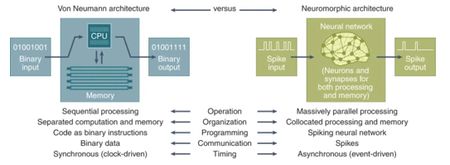Difference between revisions of "24F Final Project: Neuromorphic Computing"
| Line 1: | Line 1: | ||
''By Chris Mecane'' | ''By Chris Mecane'' | ||
| − | Neuromorphic computing, also known as neuromorphic engineering, is a fairly recent development in the realm of computational neuroscience. The goal of neuromorphic computing is to construct computers whose hardware and software mimic the anatomy and physiology of the human brain via replication of neural structure and emulation of synaptic communication <ref name ="https://www.ibm.com/think/topics/neuromorphic-computing"/>. Though still in its nascent years, the field is a source of hope for the future of computing and artificial intelligence. | + | Neuromorphic computing, also known as neuromorphic engineering, is a fairly recent development in the realm of computational neuroscience. The goal of neuromorphic computing is to construct computers whose hardware and software mimic the anatomy and physiology of the human brain via replication of neural structure and emulation of synaptic communication <ref name ="https://www.ibm.com/think/topics/neuromorphic-computing"/><ref>. Though still in its nascent years, the field is a source of hope for the future of computing and artificial intelligence. |
== Background == | == Background == | ||
Revision as of 06:26, 22 October 2022
By Chris Mecane
Neuromorphic computing, also known as neuromorphic engineering, is a fairly recent development in the realm of computational neuroscience. The goal of neuromorphic computing is to construct computers whose hardware and software mimic the anatomy and physiology of the human brain via replication of neural structure and emulation of synaptic communication [1]<ref>. Though still in its nascent years, the field is a source of hope for the future of computing and artificial intelligence.
Background
Though neuromorphic computing presently remains no more than a promising concept, it is agreed upon that the foundations of the field were laid down by Caltech's Carver Mead in the late 1980s [1]. Using human neurobiology as the model, Mead contrasted the brain's hierarchical encoding of information, such as its ability to instantly integrate sensory perception as an event with an associated emotion, with a computer's glaring lack of an ability to encode in this way; he further noted the brain alone's capacity to combine signal processing with gain control. Mead nonetheless recognized the glaring need to better understand the brain before an accurately-designed neuromorphic computer could be realized; he emphasizes the fact that it is barely understood how the brain, for some given amount of energy output, is able to perform many times more computations than even the most advanced computer [2]. Mead himself, along with his PhD student Misha Mahowald, provided the first practical example of the potential of neuromorphic computing through their development of a silicon retina in 1991, which successfully imitated output signals seen in true human retinas most notably in response to moving images [3].
